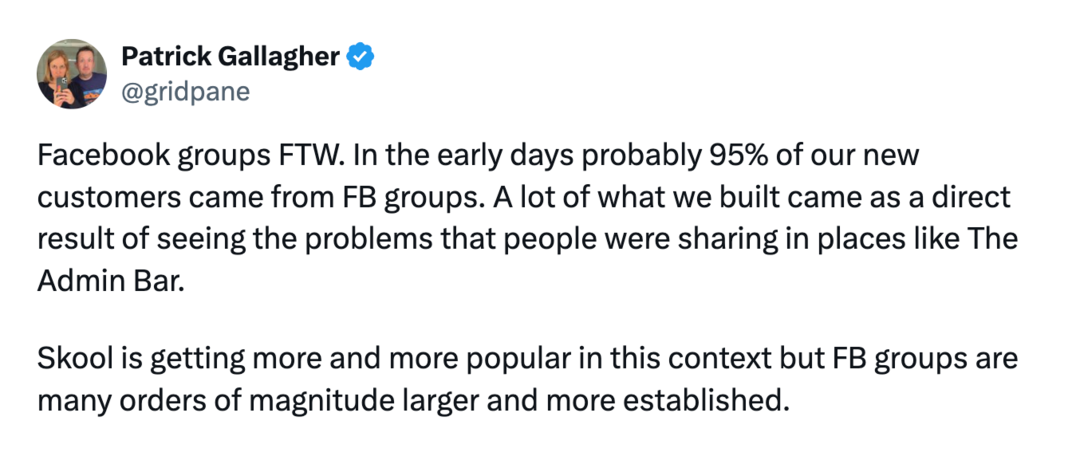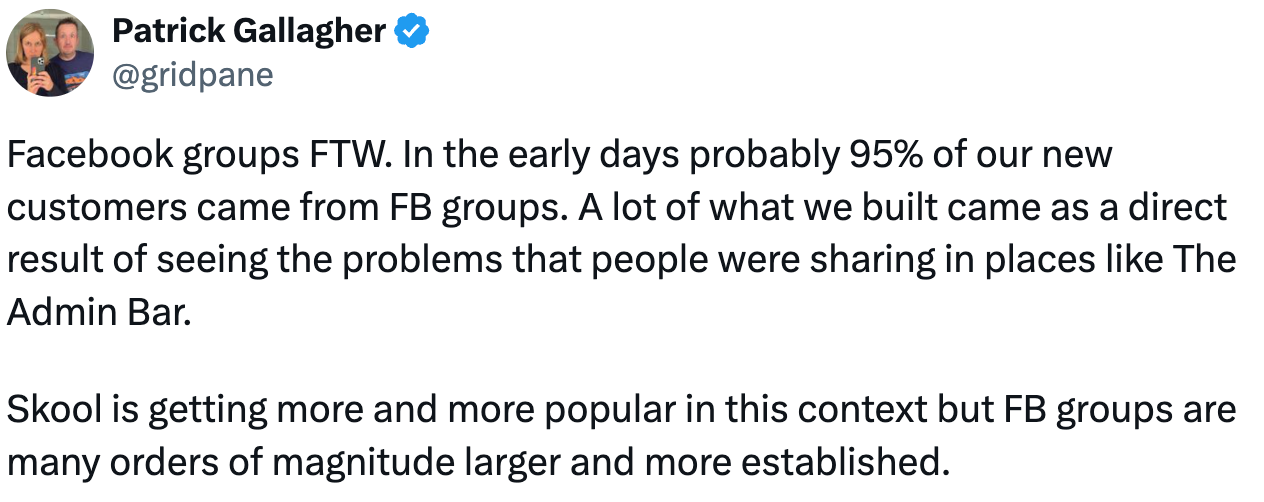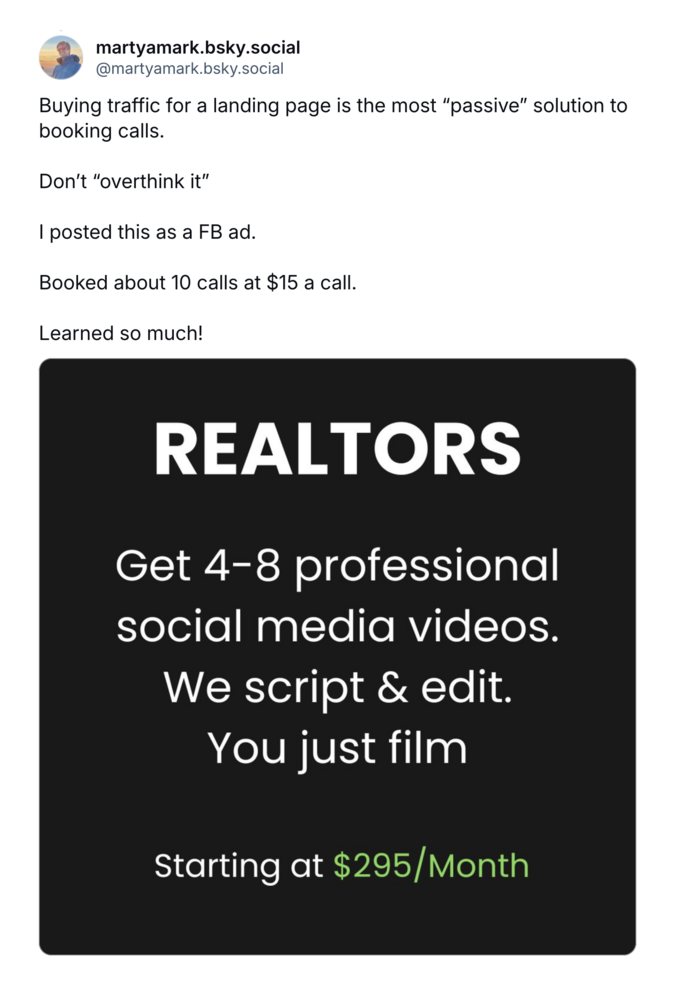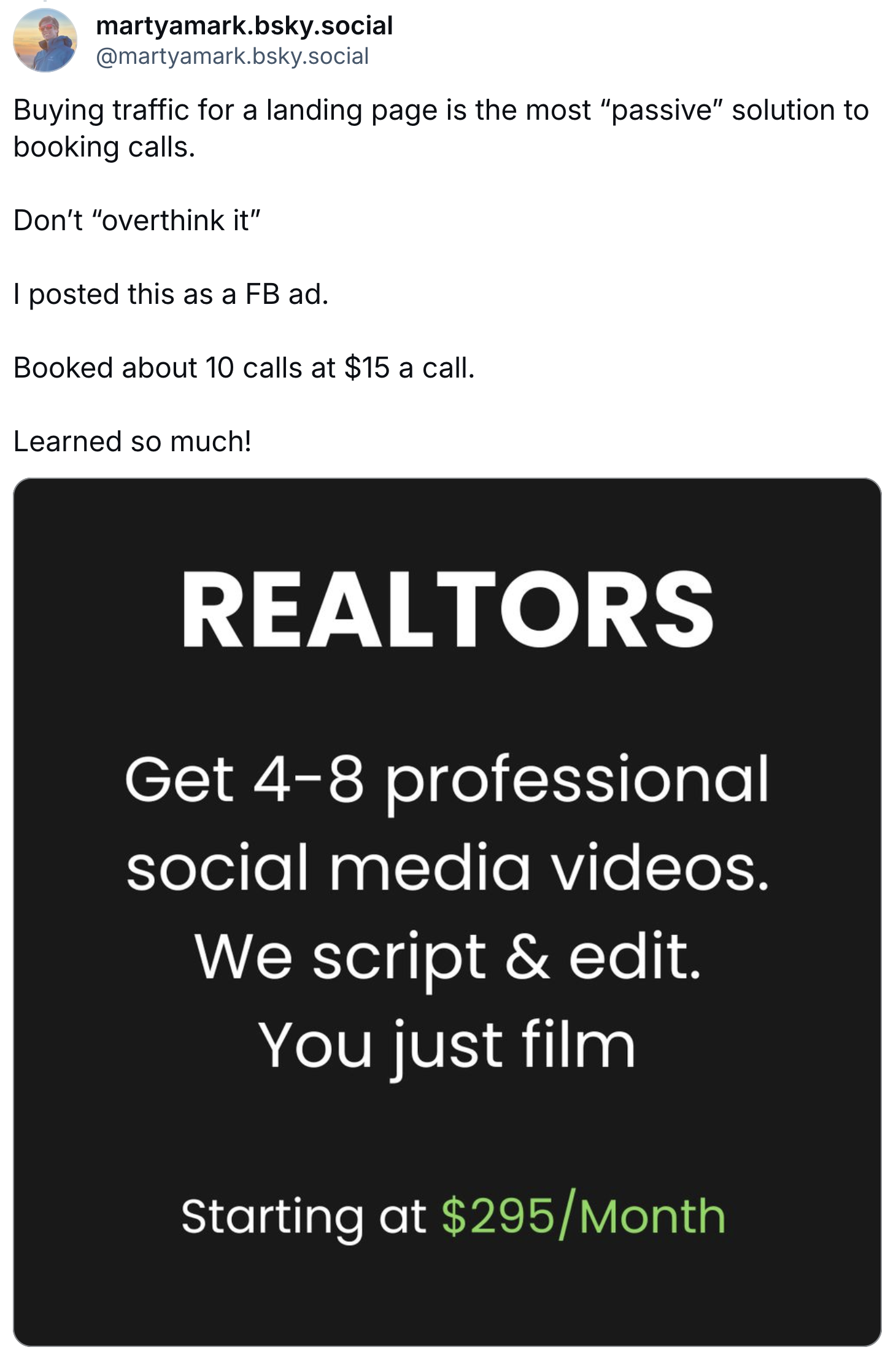When you have nothing: How to find potential customers to interview
No matter how many features, no matter how great the UX, no matter how cool the AI, if people don’t care, or don’t want to pay for it, or want it to work differently, then your company will fail.
You know; you also know you should interview potential customers before you start building.
But how do you find these potential customers? How do you get them to talk to you, when you have no brand and no product?
Ground rules
General advice applying across all techniques:
- Only interview your ICP. Early on, you’re not entirely sure who that is—fair enough—but you have a general sense. Family and friends will tell you “that sounds cool” and cannot tell you whether actual potential customers agree, and want to pay. Go where the ICPs are.
- “Good enough” is good enough at first. Best is an hour-long interview as described in the guide referenced above. But beggars can’t be choosers, so it’s OK if it’s partial or otherwise not ideal. If you run a partial interview, and the other person seems interested, always ask for a follow-up so you can go deeper; that will be 10x more valuable.
- Frame it as asking for advice. People hate being surveyed but they love getting asked for their opinion. Prostrate yourself (“it would mean so much to me to have your advice”) and compliment them (“because you’re an expert” / “… told me you’re the go-to person for this” / “I’ve really loved your article on …”).
- Make it trivially easy for the other person. Proactively send a calendar-scheduling-link so they can find a time that works for them. Have lots of time slots open so it’s not a hassle. Minimize back-and-forth communication to set up the meeting. Respect their time; don’t create barriers.
- Expect a low success rate. Cold-calling is the worst. It’s soul-crushing for you and annoying for others. Reaching out to strangers is a form of cold-calling (though many of the techniques below warm things up a bit first). A 10% response rate would be fantastic. Don’t take rejection or apathy personally. You deserve this.
Techniques for talking to potential customers
Techniques that I and other entrepreneurs have employed successfully:

Ask for referrals
Ask your entire network to introduce you to ICPs. “Your entire network” contains almost no ICPs, but they probably know some. Have a tight description of the ICP so they immediately think of the right people. Use family, friends, social media groups, LinkedIn, professors and students, social and religious groups—anyone and everyone might know an ICP to refer you to.
Then, at the end of every interview, ask who else you should talk to. Try to get two or more. People will agree but then not follow up; here’s how to recruit them to be part of the journey:
“I’m trying to have 20 conversations like this, to give this product a real shot. It’s my dream to create something people genuinely love. It would mean the world to me if you could help me by intro’ing me to a few other people who are [my ICP]”.
If you average one per interview, you have an infinite supply of interviews.
You can search by title, and sometimes get introduced through connections. See, you thought LinkedIn wasn’t a useful a social network, but it’s ideal for this quest.
The way I got interviews for WP Engine is by using LinkedIn to find people who had the title and industry I was targeting (web developers using WordPress), and asked them for an hour of their time to chat about a new startup concept for whom they are the ideal customer. Out of 50 requests, 40 agreed, and 30 eventually became customers.
How I got such a high hit rate:
- In my initial outreach, I said: “I will pay any fee you feel is fair for an hour of your time. I’m not asking for a donation; I’m genuinely interested in your expertise and opinion.” This showed respect, both for their knowledge and time. I was shocked at the response: Only one person out of 40 asked to be paid! Reciprocity works.
- I researched each person quickly—who does their business target, where are they located, was there anything in recent blog posts I could personally connect with or comment on—so that the outreach was personal. Yes, this takes time, but the conversion rate speaks for itself.
- I tried to get an intro from an existing connection. People will often help, even if they don’t know the target person too well; write the InMail for them, where you’re polite and don’t over-sell yourself, and talk like a normal person, not like a robotic marketer.

Networking Events & Conferences
People go to network events to talk, and the subject they enjoy talking about the most is themselves. Good! You want to talk about themselves too. Of course the event needs to attract your ICP so you’re not learning from the wrong crowd. Some of your questions will be more natural in that sort of environment; have 3-5 of them in mind and pick up some lightweight information.
Bonus: Have enough useful things to say to earn a speaking slot. Speakers have instant credibility during the entire conference; it will be many times easier both to start conversations and earn longer meetings later. Local meetups and larger conferences alike have a constant appetite for fresh speakers.
Bonus: Do something creative and noteworthy at the conference. At Fincon, Noah Kagan gave his speaker fee to the audience ($50 per person), telling them to use it to kick off their entrepreneurial journeys (the subject of the course he was selling).
Forums: Reddit, Discord, Slack, Facebook Groups
Selling your product in a forum is a no-no, but fortunately “customer development” is not selling; it’s learning about the lives of others. There will be multiple Subreddits / Slacks / Discord servers / Facebook Groups where your ICPs already congregate.
Use posts to ask your questions. You can probably ask all your questions over time. One post per question, and don’t flood the system. Responses will be discombobulated—responses from a single person aren’t connected like they are in a real conversation—but this is still a great way to survey and start honing your hypotheses.
Reddit, Slack, and Discord tend to work better in real-time, so lurk to discover when they are more active, both for posting new questions and to establish your reputation by responding to others. Take the time to provide high-quality answers to others’ posts and comments; communities are give-and-take, not just take. The better communities will have moderators enforcing this, and rightly so. This is a long term relationship that will carry you through the coming years, not a hit-and-run. Here’s a mini-guide from Jordan Malone on how to do this.
You might be able to do something similar with Hacker News, Quora, or even Craigslist, but those are general forums where it’s difficult to target ICPs, and almost impossible to create long-term relationships. Conversely, sometimes there are small communities with independent websites, who would welcome an additional member, or even entertain inexpensive, tasteful advertising for you to reach their members.
Don’t be too quick to ignore the old-school forums like Facebook Groups, even for modern software:
Figure 1
Ask people who are asking for help, or complaining about the problem / competitor
People rant online all the time, especially in social media (don’t forget YouTube comments), forums (e.g. Reddit, Slack, Discord, Facebook Groups), and review sites (e.g. G2, TrustRadius, Capterra). Set up searches for your area, the problem, and competitors. When someone complains, reach out, probably by finding them on LinkedIn and referencing their review. Jordan Malone has a mini-guide for this too.
Many products have a feedback site where customers can vote on pain points or features. Careful though: Your product will be different, your customer segment could be different, your goals and trade-offs will be different, and your product isn’t already mature. Still, trends can be informative, and individual people who are especially verbose are more likely to want to talk to you about it also.
Even better: Look for people who have taken action, i.e. evaluating other products, switched products, built their own workarounds, etc.. It’s free to complain, but expensive to act, so they must really mean it.
Or the positive version: People simply asking for help. “How do I ______?” Use keyword-monitoring tools, and then actually help them. Having delivered something of value, you can now ask whether they’d hop on a call to talk about it more.

Buy traffic to a landing page
Set up a one-page landing page asking for people who are interested, then buy advertising1 to send traffic there. Bid on keywords with low competition, even if volume is small; you’re looking for a few targeted visitors, not scaling a marketing channel. You will need to A/B test your ads and your landing page. Tim Ferris famously used AdWords to test book titles and market-positioning for The 4-Hour Work Week, before he was well-known and had a following; Katt has built multiple products using this method.
1 AdWords is the most obvious place to start, as it’s the most sophisticated with targeting, A/B testing, and budgeting. However, don’t forget about Twitter, LinkedIn, or even Facebook; go where your audience already is.
Getting clicks gives you a positive signal on positioning and language—useful, but it isn’t a customer interview. Your landing page will need to collect emails from people who are willing to talk. You could offer something in exchange—a gift card to Amazon, a donation to some charity, etc.. You might offer “first year is free once the product comes out.”
Bonus: Add web-chat, and pop up when someone comes to the site. When they see you’re not a bot, you’ve suddenly become a real human being instead of a cold automated form. Explain why you really value their advice, offer a fee if they’re considering but unconvinced, and appeal to the idea of helping a struggling founder with a new venture.
Bonus: Create some content that the ICP really cares about, hidden behind an email address. Then you’re giving them something valuable, sometimes earning the right to hop on a call.
Bonus: Put your self-scheduler link right on the page, or like John-Paul Anderson did for his startup, minimize conversion steps by making the scheduler be the landing page, including the fee you are paying the participant for their time.
Ask someone who knowledgeably talks about it
Anyone who is already blogging / newslettering / social-posting about this problem has demonstrated that they like talking about it; of course best is if they are the ICP. Ideally engage them first by thoughtfully responding to things so they have some connection to you. Then a chat might be fun for both of you, especially if you offer to share the results of your total findings with them. It doesn’t matter how many followers they have! Indeed, people with fewer followers are more likely to engage.
They might also be willing to ask their audience on your behalf. Maybe later they would promote your software, especially with an affiliate link. The smaller the audience, the more likely they are to work with you; so long as the niche is targeted, this is not a bad use of your time when you’re just starting out.
(Ironically this is partly how Reddit got started… and now they’re a primary source in their own right!)
Offer to write guest-posts for newsletters and blogs. These have to be fantastic though; significantly better than their median post. It works better with sites that typically feature multiple authors; worse with single-author blogs who never feature guest-posts; you’re not going to be the first exception.

Work with an influencer
Influencers have an audience, and are always looking for excuses to do something interesting with them. It doesn’t make sense for them to spam their audience for you, so get creative with how you could help the influencer:
Maybe you will gather your results, share the summary with them, and they can make an interesting post. Maybe they’d be interested in promoting the product when it comes out, with a revenue-split. Maybe you can use your prototype or expertise to give them a report that is genuinely useful to them, or you can offer up a truly great guest article / newsletter / social-post.
Pay for meetings
Websites like User Interviews (and maybe Fivvr or UpWork) are full of people who are willing to talk for money. Beware: You need a strong ICP filter. It could be that your ICP isn’t there at all.
Expert Networks like GLG and Third Bridge connect you with verified industry experts and operators. While it costs more money than most of the options here, you can often interview Directors, VPs, or even C-level officers who you may not be able to access any other way. You can have candid conversations about budget, decision-making processes, and competitive dynamics that would be awkward or impossible in other contexts.

Angels & VCs
Whether you want to raise money or not, angel investors and VCs talk to founders for a living. They often have a broader perspective on an industry, and anyway they enjoy this sort of thing. They might be able to give you insights despite not being the target customer, but take everything they say as “ideation” and not “validation” nor “insights,” because ultimately they don’t know any more than you do. If they did, they wouldn’t have such a large failure rate in their investments.
However, they probably know many people you should talk to. Having a network is also part of their job. Therefore, even if the initial meeting is mostly ideas and little validation, if they like you they are very likely to introduce you to actual ICPs.
Ask people who are professionally engaged
Your ICP probably hires people. Their job postings reveal their exact pain points - look for patterns in the “requirements” and “responsibilities” sections. Reach out to the hiring managers; they’re thinking deeply about these challenges right now and are often willing to chat about potential solutions.
Look for people who backed similar or complementary products in your industry; people who prepaid on Kickstarter or voted on ProductHunt might be more willing to talk to you.
Newly-funded startups are “on to something,” have customers of their own, and yet might be excited to talk to another founder; check Crunchbase and AngelList.
Build in public (with others)
There is a strong online #buildinpublic community. Twitter used to be the main place; now Bluesky has a strong game and is getting stronger. There’s some on Threads too. (LinkedIn isn’t very good for this). Even if you have very little following, you can join the conversations that are already happening, often under that hashtag. By commenting (usefully!) on others’ posts, and making some of your own, you build enough rapport that you can start asking them for referrals (see above). Some might directly be your ICP, but beware: other people who are just starting out are almost certainly not your ICP.
Create a free micro-tool
A great technique both for initial conversations as well as a permanent inbound marketing funnel, create a free tool that is SLC—something useful, simple, well-designed, and complete.
Indeed, one of the first companies to pioneer this method was HubSpot, who also pioneered the modern conception of Inbound Marketing on their blog and their book, appropriately-named Inbound Marketing. Even at $2B in revenue, the technique is still working, with more than 30 tools now available.

Go on a podcast
There are 4 million podcasts; most are defunct, and most have no listeners. But you don’t want listeners, you want to interview someone. Propose to the podcaster that you want to do a special episode where you interview them on this topic. It should be interesting for others to hear this level of detail; you might need to tune your questions to make it interesting in this context. Of course the podcaster must also be an ICP.
Or, create your own. It’s more work, but it can become a long-term marketing channel, as it is for Steve McLeod:
I have a podcast for the purpose of contacting my ICP and inviting them to talk about themselves for 30 minutes.
The podcast description states that it is for my ICP. Once I had done a few episodes, people with my ICP started hearing about it and would then contact me and asking to be interviewed.
What about just one line?I now have a nice waiting list of people wanting to be interviewed.
Cold outreach (email, DMs, social)
The conversion rate is low, but the outreach might be inexpensive. Like the landing page, you will need to A/B test a tight, compelling message, and the call-to-action would probably benefit from an offered reward.
Go where people are (waiting)
It’s hard to interrupt someone while they are working, or while they are going somewhere. But people standing in a line have nothing to do. This could be at a checkout line, waiting to get into an event, sitting in an airport terminal, standing in line for coffee, or between sessions at a conference. Even virtual “waiting rooms” like the comment sections of live-streamed events can work; people are just waiting for something to happen.
Sometimes you can interrupt people if you come bearing gifts. Nick Basile used free donuts to talk to university students. Karsten Duus Wetteland found people in the building where he worked; the fact that they would probably bump into each other in future made them more friendly and amenable. If you already work in the industry that your product idea is in, you can interview people at your company.
PR
For most companies, “PR”—getting articles and interviews from traditional media—is reserved for late in the maturation of the marketing department. At first you’re just trying to get those first few customers, then getting one marketing channel to work well enough to establish the company. However, if you are an expert in a topic, and have insights that others would find interesting, and are good at being interviewed, then early PR is a way not only to start establishing your brand, but to gain the credibility and inbound interest to have those initial customer conversations. You have “given first,” and now you can “take.”
In the extreme, this can take the form of “stunts,” as when Brian Chesky (AirBnB) distributed branded cereal boxes called “Obama O’s” and “Cap’n McCain’s” during the 2008 Democratic National Convention in Denver to generate buzz and media coverage, or when Alexis Ohanian (Reddit) sent personalized luggage tags with a Reddit alien logo and handwritten notes to the first few hundred people who mentioned Reddit on Twitter.
Make your own events
This is a direct quote from Giff Constable’s excellent book Talking to Humans. It’s only 80 pages; I highly recommend it.
One aspiring entrepreneur wanted to target mothers of young children. She had heard stories about talking to people in a coffee shop, but felt like it was too unfocused. So she tried hanging around school pickup zones, but the moms were too busy and refused to speak to her. Next, she tried the playground, where she figured moms would be bored watching their kids play. This worked reasonably well, but she was only able to get a few minutes of anyone’s time. So instead, she started organizing evening events for moms at a local spa where she bought them pedicures and wine. The time of day worked because the moms could leave the kids at home with their partner. The attendees had a great time and were happy to talk while they were getting their nails done.
In another example, Jitpal created an industry event with a panel of experts and C-suites; the audience was also serious people. It was a lot of cost and work, but establishing themselves this way allowed them to have many conversations with ICPs, and also paved the road to initial sales.
You can also create a local meet-up on the topic that your ICPs care about. This works better in a larger city, takes a lot of time, and can last for years. But, it also can become a permanent fixture of your brand for customers and recruiting, and a lot of fun if you’re an extrovert. You also don’t need to have an existing “following” or reputation to do it; Meetup.com helps spread the word, and multiple people have had success using that site alone.
If all this sounds like a lot of work, that’s because it is.
Good news: You only need one or two methods to work, especially if you’re good at generating new referrals from each interview. And this isn’t a process you have to do forever, just enough to either invalidate your idea, or to change your idea such that it is validated.
What definitely won’t help is creating software, adding features, and yapping about nothing on social media. So, put that stuff away, and get in front of some potential customers.
More resources
- How to create and execute customer interviews.
- Destroying your excuses for not interviewing customers.
- The Mom Test by Rob Fitzpatrick (2013)—probably the single best book on this topic, and compatible with all the articles on this site.
- Deploy Empathy by Michele Hanson (2021)—how to find and talk with customers with a mindset that unlocks what you actually need from them.
- Traction by Gabriel Weinberg (founder of DuckDuckGo and others) and Justin Mares (2015)—an under-appreciated book on how to get initial sales (or conversations). (Sometimes confused by the other book by the same title, which is also excellent but a different topic.)
Many thanks to Carter Bryden, Counterplot Consulting, Giff Constable, Karsten Duus Wetteland, Katt, Jason Evanish, Jitpal, John-Paul Anderson, Jordan Malone, Justin Jackson, Marty Markenson, Marie Strauchman, Nick Basile, Omar, Patrick Gallagher, Steve McLeod, Tony Meijer, Tino Go, and Wim Cools for contributing their experiences.
https://longform.asmartbear.com/find-customers-to-interview/
© 2007-2025 Jason Cohen
 @asmartbear
@asmartbear ePub (Kindle)
ePub (Kindle)
 Printable PDF
Printable PDF

















